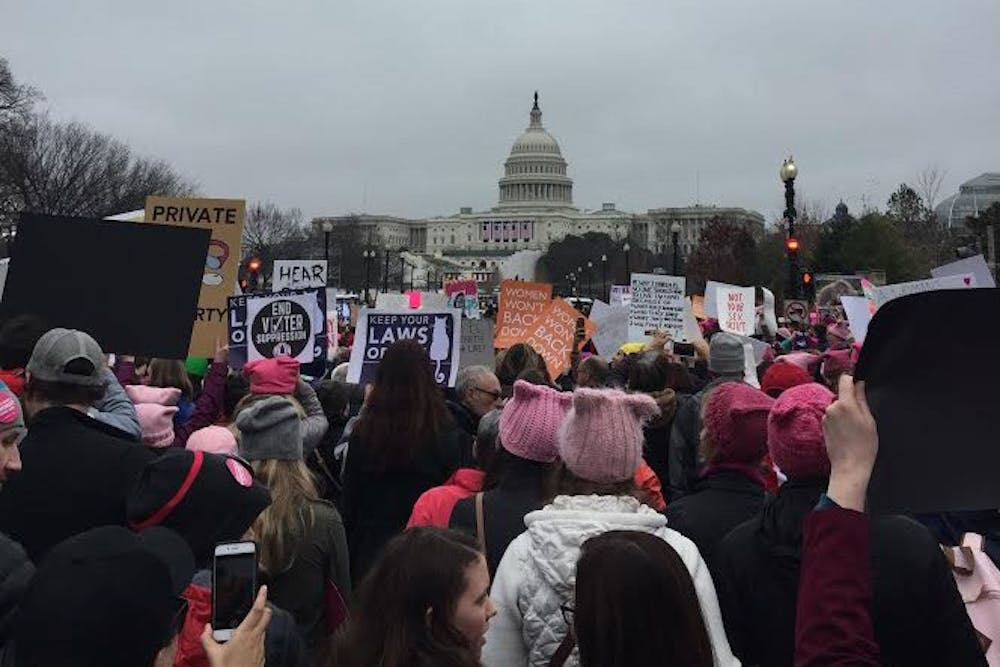The day after President Donald Trump’s inauguration, a crowd of nearly 500,000 people — men and women alike — gathered in the nation’s capital to participate in the Women’s March on Washington. Many University students took part in the protest for women’s rights, marching from the southeast corner of the National Mall to the Washington Monument on Constitution Ave.
The march drew approximately three times the size of the crowd that attended President Trump’s inauguration, according to crowd counting experts.
The Women’s March conflicted with the timing of sorority recruitment, and while several sororities allowed their members to attend the march without penalty, others did not.
Marching for women’s rights as human rights
The Women’s March on Washington was a grassroots effort calling for the new presidential administration to recognize “women’s rights as human rights,” according to the event’s official website.
The event began with a rally at 10 a.m. that included speakers ranging from actresses to the mothers of victims of police shootings and performers such as Alicia Keys, Janelle Monáe and Madonna.
Second-year College student Anna Morgan said in an email statement she attended the march because she believes strongly in what it symbolizes.
“It is especially important given the past election and the fear and uncertainty that it has instilled in so many women,” Morgan said. “I have family and friends that are genuinely concerned about their well-being and rights.”
The march is rooted in eight “unity principles” highlighting specific aspects of women’s rights, including reproductive rights, immigrant rights, LGBTQ rights and ending violence against women.
University students at the march
The day began early for the students attending the march, and the crowds started to become very crowded quickly.
“By 8 a.m., the crowd had already gathered at this Metro stop and lines extended almost to the parking garage,” second-year College student Logan Brich said in an email statement. “The metro car itself was packed shoulder-to-shoulder despite having begun empty, so much so that subsequent stops were only to pass time for cars ahead of us.”
Similarly, first-year College student Summer Harvey boarded a bus at a church in her hometown in Purcellville, Va. at 7:30 a.m.
“It took us probably two hours to get there even though we really only live 45 minutes away because traffic was packed,” Harvey said.
The traffic worsened as they got closer to Washington D.C., and only buses were allowed into the city, Harvey said. People who wanted to attend the march started getting out of their cars and walking on the side of the highway to reach the rally.
Both Brich and Harvey said the journey to the National Mall was filled with protesters holding signs, cheering and chanting — regardless of if they were walking the streets or standing on the platform at the Metro stations.
Harvey was able to get close enough to stand behind the stage.
“We listened to Michael Moore speak, the mayor of D.C. speak and one other person, and then it was getting really crowded so they cut off the back stage, telling us that we had to go to the front,” Harvey said.
Although the march was scheduled to begin at 1:15 p.m., Brich said the rally did not end until 2:30 p.m. The march began after the rally finished, but Harvey said there was confusion among the crowd about the route of the march.
“That was kind of interesting because there were way more people than expected so they had to shut down the route of the march … but everybody was still chanting and cheering and yelling,” Harvey said. “No one knew what was happening so people just started climbing trees and women had their shirts off, and there were signs everywhere.”
Brich said that due to the crowds, many of the protesters cut across the Mall to regroup on Pennsylvania Ave. and march toward the White House.
“Despite the enormous amount of people in attendance, the message of unity and resoluteness permeated the crowd and carried it civilly forward,” Brich said, calling the environment “overwhelmingly beautiful.”
Conflicts with sorority rush
The march conflicted with sorority recruitment at the University, requiring many women who wanted to attend the march to risk the consequences of skipping a day of recruitment, such as fines.
The Inter-Sorority Council responded to the conflict by organizing a second march at the University set for Tuesday, Jan. 24.
“I really appreciate that the ISC has put together a separate march,” first-year College student Virginia Chambers said. “I think that that shows some solidarity even if there is a little bit of inflexibility.”
Though recruitment week is tough to miss for any sorority woman, some found it necessary to do because they wanted to have their voices heard by participating in the historic march.
“I want to make a difference by showing that I will drop everything and drive to D.C. and participate in this monumental moment,” Gamma Phi Beta member Morgan said. “The Women's March is possible because thousands of individuals have decided to go and support one another and stand for what they believe in. I want to feel that energy and be a part of something so electric that I feel it pulsing all around me.”
When asked if she would face a fine for attending the march, Morgan said she wasn’t allowed to comment.







